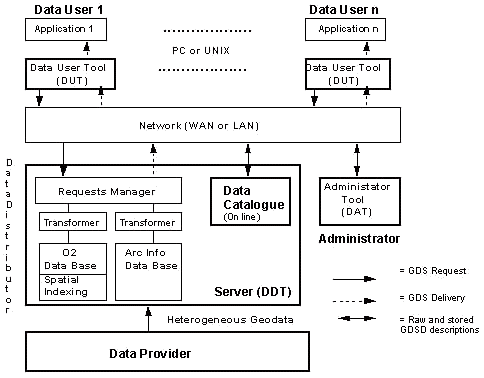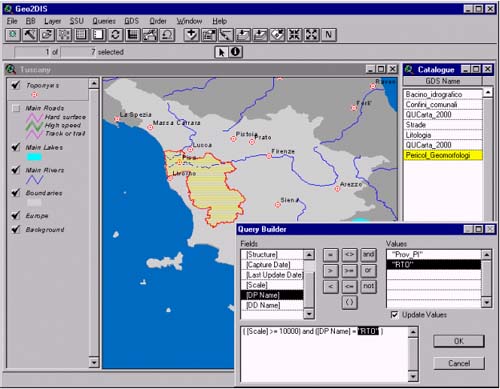 |
| BEYOND WEB-MAPPING: CATALOGUING, PROCESSING AND DOWNLOADING ARCINFO DATA ON INTERNET |
| Andrea Musone Intecs Sistemi SpA, via L. Gereschi 32, 56127 Pisa (Italy), phone +39 50 545111, fax +39 50 545200, Web: http://www.pisa.intecs.it/, email: andream@pisa.intecs.it Abstract In the world of
distributors and users there is the need of documenting
and accessing geodata. Users have their own GIS
applications (many based on Esri products), and they need
to know which suitable geodata are available and where,
and how to access them. Internet Map Servers don’t
solve all their problems, since GIS applications often
move beyond simple map making, only a few have been
ported on the Internet/Web, and porting is costly. Apart
of legal constraints, access to geodata is limited by the
poor knowledge of data availability, the geographical
distribution of users and distributors and the data
stored in multiple, heterogeneous GISs. Therefore users
need to locate the data, determine (through the metadata)
if the data meet their application needs, and transfer
the data. These needs move beyond the download of
predefined export files. INTRODUCTION Worldwide large amounts of geodata are available in an unlimited number of different forms, like:
The data volume is increasing
exponentially in amount, capacity and variety. Data are
stored on heterogeneous, world-wide distributed,
geographical databases (GISs). To potential data users
the information on data availability and accessibility
are very poor. It is getting more and more difficult to
use data efficiently and bringing them within GIS
applications. E.g., currently only 2% of all existing
remote sensing satellite data are being used within GIS
applications.
The universally accepted answer to
these requirements are the "Spatial Data
Infrastructures". Several and authoritative
initiatives have started already, either at International
level (GSDI, Global Spatial Data Infrastructure), in the
US (NSDI), in Europe (ESDI) and in Italy (e.g. by AIPA).
Some of these are still in progress while others have
already become reality.
The requirements of users having own GIS applications can't be tackled easily with the Web mapping technology. Though powerful and innovative (Esri solutions first) it is still unconceivable that more than a limited part of the current GIS applications might be ported on the Web, with users simply accessing "application servers" with their Web browser, and having available the very same functionality. This is hopefully advised soon to come (mainly thanks to OpenGIS), but not yet beyond the corner. Therefore the GIS interoperability through data export and transfer is still expected to last for a while. GIS BROKER DEMONSTRATOR With the introduction of powerful
desktop computers, corporate servers, the Internet and
Intranet technology, the Web, low-cost desktop GIS
viewers (e.g. ArcView) and the like, the requirements
above can become implementation reality.
The user invokes the Client, generically identified as Data User Tool (DUT), in order to discover suitable geodata for his/her application. The Client is available either on ArcView or on the Web (via a mere browser) and on any Unix/PC platform. The Client lets users interactively navigate a Catalogue of metadata by formulating alphanumeric queries on these items:
Spatial queries are also possible
on a displayed Background Cartography of the concerned
area, i.e. intersect & "fully within"
operators between an arbitrarily user drawn Area Of
Interest (AOI) and the geodata spatial extensions (alias
"footprints"). Note that footprints in the
Catalogue are stored in their source shape, and not
rounded to their bounding box. In reply to a query the
user receives the successful hits as full metadata
records. These comprise the items above plus other
metadata elements, such as geographical objects (e.g.
lines), attributes and their values, browse graphic,
available formats and projections (one-of many), and
other elements where needed (e.g. for compliance with
CEN/TC 287 or ISO/TC 211 standards). The user can then
display the records at will and see their spatial
extension on the Background Cartography.
The Catalogue contains, for each
dataset, the controlled list of available formats (e.g.
E00, SDTS, DXF) and projections (e.g. UTM, Gauss-Boaga).
The generic request, via Internet, is sent to the Data
Distribution Tool hosting the desired data. The Server
parses the request (stated in GeoQL, extension of ODMG
'93 OQL), and translates it onto the specific language of
the GIS hosting the data (through programs called
Transformers). The specific request is then executed by
the involved GIS and, when the process terminates, the
Server asynchronously returns to the user, through
electronic mail, the address of the produced data (e.g. ftp://ftp.pisa.intecs.it/pub/rivers.e00). The user can then retrieve the data and
use it in his/her GIS application. TOWARDS THE FUTURE At the time of the Web implementation the ArcView Internet Map Server (AV IMS) was not available on the desired Unix platform. Therefore the Web Client has been fully implemented in Java, exploiting a Java applet accessing the Catalogue (hosted on Informix Dynamic Server) via a JDBC-compliant API. It is under design the porting of the Web Client on AV IMS, in turn accessing the unified Esri SDE and Informix Spatial DataBlade technologies.
|
     |
    |
 |
| [Introduction] [Conference programme] [Presentation by authors] [Presentation by category] [Poster session] [List of european Esri distributors] [List of exhibitor] [Esri products news] [Credits] |

